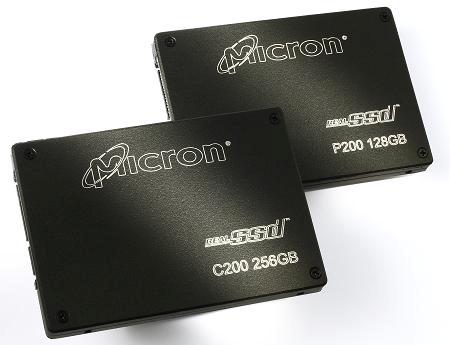One of the world’s leading providers of advanced semiconductor solutions, Micron Technology has announced its next-generation RealSSD solid state drives – enterprise-class RealSSD P200 and client-focused RealSSD C200. The Micron RealSSD P200 will use high-performance single-level cell (SLC) NAND technology for enterprise computing, while the RealSSD C200 using multi-level cell (MLC) NAND process technology for notebook applications.

“We are seeing SSD interest in a variety of applications where historically hard disk drives have reigned. For many, the most logical place is in notebook computers, but there is incredible value for SSDs in enterprise server systems,” said Dean Klein, vice president of memory system development at Micron.
The RealSSD P200 line that ranges from 16GB to 128GB in 2.5-inch form factor will provide industry’s fastest 3Gb/s SATA-based sequential read and write speed of up to 250 MB/s.
Key Differentiating Benefits Of Micron’s Enterprise-Class RealSSD P200:
- Performance – The P200 is more than 10 times faster at accessing transactional data when compared to a typical enterprise HDD. It achieves sub-millisecond latency while a typical enterprise HDD has an average latency of approximately eight milliseconds, dramatically reducing the data seek time inherent with conventional HDDs.
- Power – The P200 consumes about one-tenth the power of a typical data center hard drive, operating at 2.5 watts in active mode and under at 0.3 watts in idle. In contrast, data center hard drives typically consume anywhere between 8 to 28 watts. Additionally, with its low-wattage and high temperature range (the P200 operates at a temperature range of zero to +70 degrees Celsius where an HDD operates at +5 to +55 degrees Celsius) the P200 requires almost zero cooling, keeping power consumption low.
- Reliability – The P200 is ideal for the demanding reliability requirements of mission-critical enterprise applications. The P200 provides improved wear-leveling capabilities across its high-performance SLC write cycles, offering a mean time between failure (MTBF) rate of approximately two million hours compared to 300,000 to 500,000 MTBF of an HDD, dramatically reducing the concerns of a mechanical breakdown.
“With our C200 products, we are providing a balanced price to performance solution specifically designed for notebook applications by utilizing MLC NAND technology and highly optimized NAND management algorithms,” added by Klein.
According to the company, “The 2.5-inch C200 will be offered in densities of up to 256GBs. And with its small form-factor, the 1.8-inch C200 will range in density from 32GBs to 128GBs offering uncompromised power and performance levels. Using a 3 Gb/s SATA interface, the C200 products provide a read speed of up to 250 MB/s and a write speed of up to 100 MB/s. The increased read and write speeds of the C200 will enable consumers to have an overall improved computing experience when compared to a notebook designed with an HDD, offering improved boot and application load times and lower power consumption for smaller form factor notebook designs.”
The Micron RealSSD P200 and C200 solid state drives are expected to go into mass production by Q4 2008.